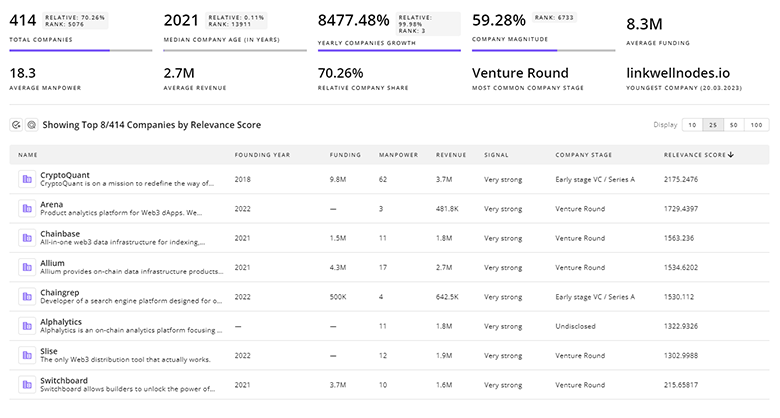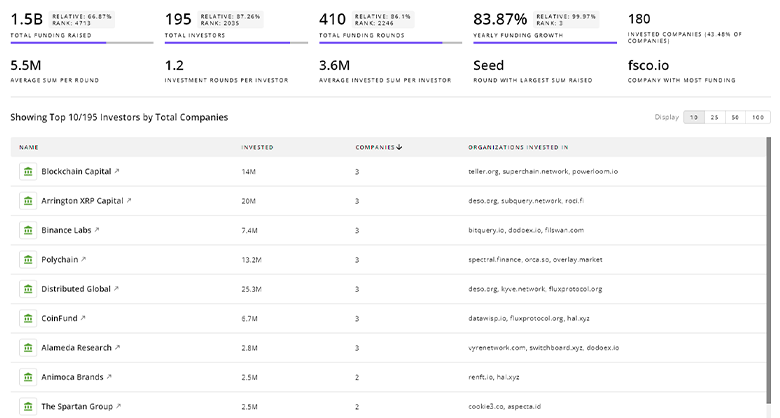
Emergency Medicine Report
: Analysis on the Market, Trends, and TechnologiesThe emergency medicine landscape is marked by a network of 2,365 companies and a 28.56% annual increase in funding rounds, reflecting strong investor engagement. The global emergency care market is forecast to rise from $844.8 billion in 2020 to $1.4 trillion by 2025 at an 8.5% CAGR, driven by digital health integration and consumer demand for remote services.
This article was last updated 69 days ago. If you find any info is missing, let us know!
Topic Dominance Index of Emergency Medicine
The Dominance Index of Emergency Medicine looks at the evolution of the sector through a combination of multiple data sources. We analyze the distribution of news articles that mention Emergency Medicine, the timeline of newly founded companies working in this sector, and the share of voice within the global search data
Key Activities and Applications
- Telemedicine Consultations: Remote video and audio triage networks connect patients to board-certified emergency physicians 24/7, reducing unnecessary ER visits and exposure risks during pandemics (The Future of Emergency Medicine: 7 Key Trends – ApolloMD).
- AI-Driven Triage and Diagnostics: Machine-learning platforms analyze vital signs and imaging to identify high-risk cases, accelerating decision-making and optimizing resource allocation (AI in Emergency Medicine: Innovations Shaping the Future – Matellio).
- Data Analytics for Operational Efficiency: Advanced analytics track patient flow, length-of-stay, and outcome metrics to pinpoint bottlenecks, reduce wait times, and improve care quality (Emergency Medicine Data Analytics | MGH IHP).
- Emergency Department Information Systems: Integrated EDIS platforms streamline registration, bed management, and resource tracking, helping EDs reduce crowding and staff burnout (Six tech trends that are shaping hospital emergency departments).
Emergent Trends and Core Insights
- Physician Shortages and Burnout: Only 7% of Korea’s EM training slots were filled this year, highlighting global workforce gaps that threaten 24/7 care availability (Only 7% recruited: Korea’s emergency medicine faces severe shortage).
- Point-of-Care Ultrasound Adoption: Bedside ultrasound use has surged for rapid trauma and cardiac assessments, improving diagnostic accuracy outside radiology suites (Point-of-Care Ultrasound—History, Current and Evolving Clinical Concepts in Emergency Medicine).
- Emphasis on Safety Protocols: Rigorous research on quality-and-safety methods is driving standardized protocols to reduce diagnostic and treatment errors in high-pressure environments (A comprehensive review of research methods in emergency medicine quality and safety).
- Financial Pressures: Declining reimbursements and rising uncompensated care are forcing EDs to adopt cost-control tools and revenue cycle analytics to maintain solvency (Emergency departments complain of lack of insurance compensation).
- Specialty Recognition: Spain’s approval of EM as a formal specialty will standardize training and potentially improve retention and clinical outcomes in the region (Spanish Government Approves Emergency Medicine Specialty).
Technologies and Methodologies
- Point-of-Care Ultrasound (PoCUS): Portable ultrasound devices enable immediate visualization of internal injuries, shifting key diagnostics to the front line.
- Telemedicine Platforms: Secure apps facilitate remote consultations, triage, and patient monitoring, decreasing unnecessary ED traffic.
- AI and Machine Learning: Predictive algorithms forecast patient deterioration and guide treatment prioritization in crowded EDs.
- Advanced Data Analytics: Real-time dashboards aggregate operational and clinical metrics to drive continuous improvement.
- Electronic Patient Care Reporting (ePCR): NEMSIS-compliant reporting tools capture prehospital data, improving handoffs and billing accuracy (Creative EMS).
Emergency Medicine Funding
A total of 306 Emergency Medicine companies have received funding.
Overall, Emergency Medicine companies have raised $9.9B.
Companies within the Emergency Medicine domain have secured capital from 933 funding rounds.
The chart shows the funding trendline of Emergency Medicine companies over the last 5 years
Emergency Medicine Companies
- OnERcall: A telemedicine platform connecting patients to US-licensed emergency physicians 24/7 via HIPAA-compliant video and audio. OnERcall reduces unnecessary ER visits by offering live triage guidance, addressing pandemic-related exposure fears, and aiding patients without primary care access.
- Emergency Medicine Core Training (EMCT): An online CME program covering 14 modules of EM fundamentals, including “can’t-miss” diagnoses. Developed by veteran physicians, EMCT offers multimedia learning (videos, challenges, assessments) and fulfills 156 hours of AMA/ACEP credits, strengthening transitions for NPs and PAs new to the specialty.
- EMS Event Medical: Specializes in mass-gathering medicine, providing paramedics, medical planning, and post-event reviews for festivals and sporting events. With over 30 years’ experience in NSW, EMS Event Medical supports safety protocols, supply logistics, and research dissemination to professionalize event care.
- Premier Pediatric Solutions LLC: Offers high-yield clinical simulations and a proprietary assessment tool to integrate pediatric emergency protocols into adult EDs. Tackling a $76.3 billion annual PEM market, the company targets misdiagnoses, equipment gaps, and protocol inconsistencies to improve outcomes and drive hospital revenue.
- Mednition: Deploys the KATE AI platform to empower nurses to detect high-risk patients faster without workflow changes. Awarded FDA Breakthrough Device designation for its sepsis module, Mednition enhances situational awareness and timely intervention in fast-paced ED environments.
Uncover actionable market insights on 2.6K companies driving Emergency Medicine with TrendFeedr's Companies tool.

2.6K Emergency Medicine Companies
Discover Emergency Medicine Companies, their Funding, Manpower, Revenues, Stages, and much more
Emergency Medicine Investors
Get ahead with your investment strategy with insights into 703 Emergency Medicine investors. TrendFeedr’s investors tool is your go-to source for comprehensive analysis of investment activities and financial trends. The tool is tailored for navigating the investment world, offering insights for successful market positioning and partnerships within Emergency Medicine.

703 Emergency Medicine Investors
Discover Emergency Medicine Investors, Funding Rounds, Invested Amounts, and Funding Growth
Emergency Medicine News
TrendFeedr’s News feature offers access to 7.3K news articles on Emergency Medicine. The tool provides up-to-date news on trends, technologies, and companies, enabling effective trend and sentiment tracking.

7.3K Emergency Medicine News Articles
Discover Latest Emergency Medicine Articles, News Magnitude, Publication Propagation, Yearly Growth, and Strongest Publications
Executive Summary
Emergency medicine is transitioning toward integrated digital models that enhance access, accuracy, and efficiency. Telemedicine and AI-driven tools are reducing non-emergent visits and accelerating critical decision-making. Meanwhile, advanced training programs and specialized event-based services are fortifying the workforce and extending care beyond traditional settings. Stakeholders who invest in data-driven operations, targeted education, and patient-centric technologies will be best positioned to navigate workforce challenges, financial pressures, and evolving care standards in this high-stakes segment of healthcare.
Have expertise in trends or technology? Your input can enrich our content — consider collaborating with us!








